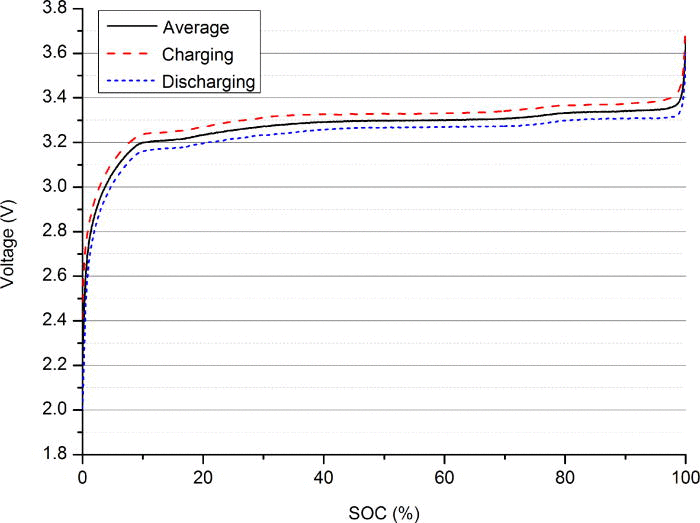While it may be difficult to determine state of charge of a LiFePo4 bank just from voltage, I do think if my voltage was essentially unchanged from November to the following May (according to Victron meter) that is a reasonable indication that the battery was in the same state of charge after that time. I may not be able to say 53.25 volts is 78% charge but I think I can say that 53.25 is more than 53.20. And if my measurement went from 53.25 to 53.24 over the winter can I take form that that I didn't loose any significant charge?
But you are correct about the difficulty of determining state of charge from voltage. That's why I have the shunt meter to track current in/out of the battery. It does require that you establish a 100% reference level.
Also, the charge curve is not flat at the bottom or at the top. So the voltage change from 100 to 98% is much larger than from 60 to 58%. Sort of a moot point for me as I never take the bank to that charge level preferring to operate in the 20 to 95% range for my use. Or maybe 97%.
Dan Pfeiffer
I don't know where this graph came from but I think it is representative...

So LiFePo stays fairly high voltage until it nears the very end but the older Lithium Ion chemistries have a slow drop of voltage until near the end so it's easier to determine the remaining capacity by voltage with that chemistry?
So really we're talking about what the chemistry is. But to my point, if you do have the LiFePo, these examples of how little loss someone had after leaving the boat in the cold for years evidenced through checking of the voltage; it's is insufficient. They would have to have run tests after the winter to see how much energy was actually left. (Unless they had the other chemistry.) The only reason I keep bringing this up is that I've checked the voltage on my batteries when full and accidentally left my fridge that should have brought the batteries down and the monitor was disconnected. I reconnected it and the voltage was the same (13.3 I believe). I would say the battery was approximately 50% discharged based on how long the fridge had been running. So putting my monitor back on, the voltage read the same, and the monitor either said 100% or 0%, I forget. But that left me in an awkward position of figuring out how long to charge the batteries back up and know they are full. (The bms is built into the battery with no way to read. Something I'll avoid in the future) I could only let the solar panels charge them for long enough that I was confident surely they must be full and made sure the monitor was at 100%. If I could tell from the voltage there wouldn't be so much guessing.
On Sun, Oct 29, 2023 at 6:21 PM Myles Twete <matwete@comcast.net> wrote:Not all lithium acts like this.
While a fairly flat discharge curve is seen with Lithium Iron Phosphate (LiFePo or LiPo), it is not the case for Lithium Ion chemistries. As example, the batteries in my pack---Fully charged they reach 49.2v. Fully discharged voltage is about 30v (2.5vpc). That's a nom. 40% drop in voltage making it quite easy to estimate the remaining capacity of the pack by voltage monitoring alone.
From: electricboats@groups.io [mailto:electricboats@groups.io] On Behalf Of Larry Brown
Sent: Sunday, October 29, 2023 5:39 AM
To: electricboats@groups.io
Subject: Re: [electricboats] Need 48v 200A for Electrictyacht 10kW motor, should 1 get 4 x NPP12V 200Ah Li or 2 Dakota 48V 96Ah?
Unless I'm wrong, my understanding is that lithium doesn't drop in voltage as you deplete them like lead acid and the voltage stays high right up until they reach capacity. So the only accurate way to gauge loss is through a battery monitor watching the draw from the system. But drain from low temp which I don't even know if it's a thing wouldn't be tracked with a monitor. You'd have to draw it down when you get it ready in the spring and watch the monitor to see how long it lasts. That would be the sure way. But I don't think they lose much from temp. I just understand they perform better at optimal Temps and worst at extremes. There are experts in this list so I'll let them chime in and maybe learn a thing or two 😁
On Oct 28, 2023, at 10:52 PM, THOMAS VANDERMEULEN <tvinypsi@gmail.com> wrote:
Very interesting, Dan. Thank you for the information. No doubt your batteries are of nobler pedigree than mine. I was always over-protective of our kids as they were growing up, but it never did me or them any harm. In any case, there's still the matter of getting one of those 48v monoliths into my motor space without a hoist and without cutting the opening bigger.
To each his own, I guess!
You're on Erie, then; what port?
Cheers!
[-tv]
--
Larry BrownS/V FelicityPlacida, FL~~~~~~~~~~~~~~~~~_/)~~~~~~~~~ ~ ~~ ~~ ~~_/) ~ ~ ~ ~~ _/) ~
No comments:
Post a Comment